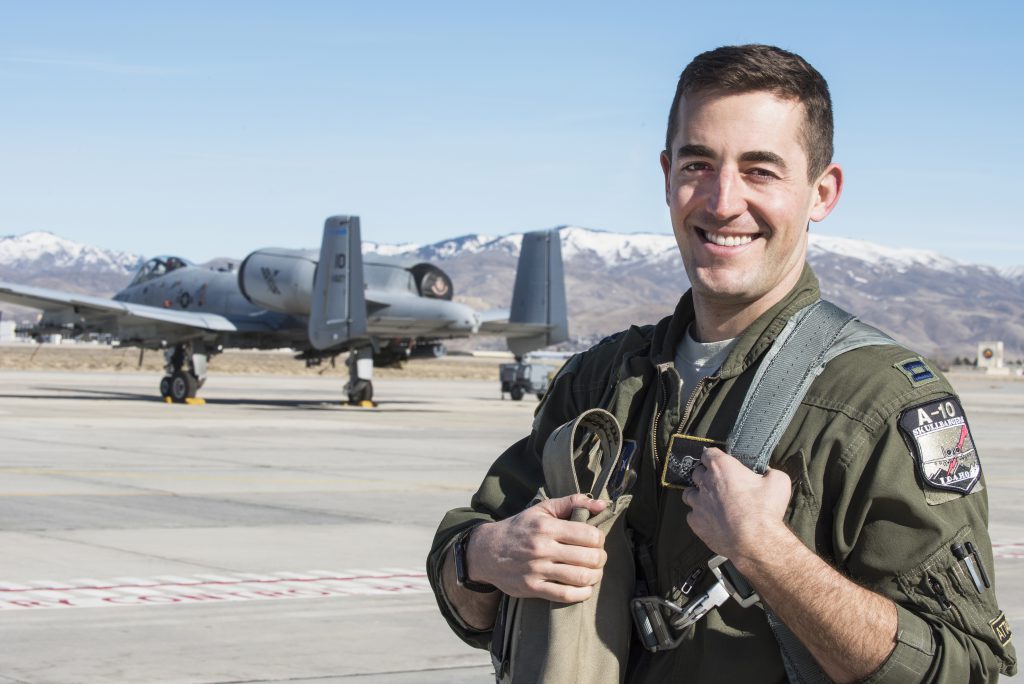A day in the life of an A-10 fighter pilot

By Master Sgt. Becky Vanshur
Idaho Military Division Public Affairs
GOWEN FIELD, Idaho — Spend a day flying with Capt. Mike Shufeldt, one of the Idaho National Guard’s A-10 Thunderbolt II pilots, and feel firsthand what it is like to be an A-10 fighter pilot.
He can smell the strong scent of coffee brewing from the kitchen, as he brushes his teeth. It’s early in the morning, but his dog, Poppy, sits at his heels patiently waiting with a ball in her mouth and tail wagging. Shufeldt grabs his thermos of coffee, throws the ball a couple of times for Poppy, pats her furry head and walks out the door.
The commute across the Treasure Valley isn’t too bad as he heads down the interstate, even with the sun shining in his eyes as it rises above the beautiful Idaho foothills. Shufeldt approaches the main gate of Gowen Field, Boise’s Air Terminal and National Guard Base, with a smile on his face. Today is a good day to fly the mighty A-10 over the nearby Orchard Combat Training Center.
Shufeldt enters the building of the 190th Fighter Squadron and prepares for his day. He gets dressed in his flight G-suit, then his harness for his seat and parachute, and he grabs his high-tech flight helmet. Preparing for his flight and the training mission can take up to two hours. At the operations desk, he listens to his step brief. Today, he is called Bang 11.
The step brief is for him and his wingman, the additional pilot flying the second aircraft on this morning’s training mission. They are briefed on the weather, coordinates, weapons and the close air support mission they are about to fly.
“Bang 11, you are clear to step. Attack,” are the last words said before he heads out to the flight line where his A-10, commonly referred to as a Warthog, is patiently waiting. It is nearing 9 a.m. as he begins the 45-minute preflight check. He walks around his A-10, scanning for any visible issues.
“I do a full preflight inspection on the outside of the jet, to make sure there isn’t anything I see wrong,” said Shufeldt. “Usually there isn’t because our crew chiefs and our maintainers are really good. They are the best, actually.”
He climbs up the ladder and straps into his seat. He and his crew chief turn on the auxiliary power unit and fire up the twin turbine engines. “Clear on one,” said Shufeldt. “Good start on one,” is the response. “Clear on two.” “Two is clear,” is echoed back to him and the two engines are now fired up.
“We check everything, from the brakes to the rudders to the digital systems inside the jet,” said Shufeldt.
Both Warthogs are now ready for flight. “Pull the chalks, see you soon,” said Shufeldt. He disconnects with his crew chief, they salute and he taxis to the runway, stopping near the end to have his A-10’s weapons armed.
The powerful Warthogs line up. Shufeldt is out front. Once cleared for takeoff, he steps firmly on the brakes and runs up the engines. As he eases the throttles forward, the 12-and-a-half-ton beast starts to shake as it reaches nearly 20,000 pounds of thrust.
After checking his gauges and instruments, he pushes the throttles to maximum and releases the brakes. The mighty Warthog gains speed quickly, reaching approximately 150 miles per hour before he pulls back on the stick and the tires leave the runway.
He is up in the air. He takes a deep breath. A moment of calm, but it is short-lived as he begins his in-flight checks and focuses on the mission. He flies toward the target area.
The sun is just above and to the left, the heat from its rays beating down on his neck, the only portion of skin that is exposed.
He can see several dirt roads below in the vast desert and sagebrush-filled land of the OCTC as he approaches the target area near the ground troops below. They are providing ground support while shooting training targets.
“Bang 11 in from the south, guns,” said Shufeldt. “Bang 11, cleared hot,” said the ground troop on the radio below, providing Shufeldt clearance to shoot the 30 mm Gatling gun. “Bang 11, good hits,” is heard after the rounds are fired.
After expending all weapons, he has completed the training mission. Before flying back to Boise, the pilots check each other’s aircraft for any issues. This is called a battle damage check. The A-10s fly wingtip to wingtip, then Shufeldt dips below his wingman’s aircraft and looks up, checking the belly of the A-10. They switch positions and fly back in formation to Gowen Field.
Shufeldt lands, taxis the satisfied Warthog back to the flight line and parks in the same spot in which he started. He reverses the order of the prefight for the shutdown procedures with the crew chief. Once inside, he debriefs the mission with his wingman. It is nearing 1:30 in the afternoon and he is hungry. He warms his lunch, a stir-fry he cooked the night before.
Pilots, like any Airman, have additional military training and duties. He completes these, spends an hour at the gym and heads home.
He walks through the front door with barely enough time to close the door behind him as Poppy jumps up as high as she can, almost knocking him over. Shufeldt is home now after a day in his life as an A-10 fighter pilot.
 Official Government Website
Official Government Website